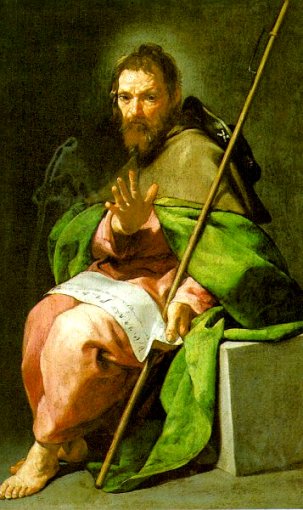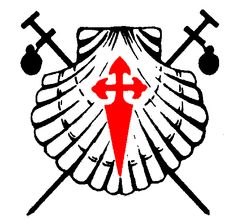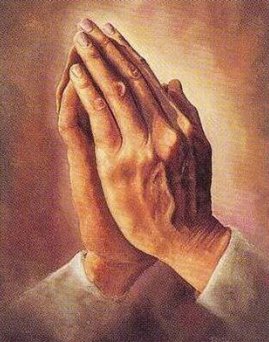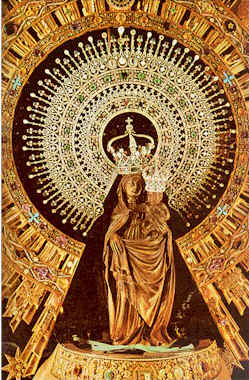Saint James Major (the Greater)

Saint James the Greater
(son of Zebedee and older brother of John)
Feastday: July 25
Also known as: Jacobus Major; James the Great
This James is the brother of John the Evangelist and the son of Zebedee and Salome. After Andrew and Simon this two (James and John) were called by Jesus as they worked with their father in a fishing boat on the Sea of Galilee. Without argument or discussion, James and John left their boat and even their father behind, and followed Jesus to become “fishers of men”. With Simon Peter, James and John were the only ones of the apostles that Jesus gave a special name: "Boanerges" (Sons of Thunder).
James is called Saint James the Greater (equals “The Older” or “The Taller”) as distinct from his fellow-apostle James the Less (equals “The Younger” or “The Shorter”).
Following Good Friday, The Resurrection, Ascension of Jesus into Heaven and that wonderful decent of The Holy Spirit at Pentecost, James commences his own ministry. He spread his gospel over Israel and then soon after over the Roman kingdom. Then he travelled to Iberian Peninsula and arrived about 40 years after Christ in the village of Zaragossa in Northeast Spain. Nine others accompanied him on this journey. The name James is “Sant Iago” in Spanish. The country of his choice was not very enthusiastic reacting to the good news. This caused him to be very sad. One day whilst he was at prayer The Blessed Virgin appeared to him. Giving him a small wooden statue of Himself and a pillar (Jasper). She told him build a church in Her honour with the statue and pillar standing on the altar forming the name of this temple: “Our Blessed Lady of the pillar”. James built the chapel on that spot to the honour of The Blessed Virgin and placed the statue on the pillar.
Some time later, James, returned to Jerusalem where he was captured and beheaded by the sword, under Herod Agrippa I; thus becoming the first of the apostles to die. Because he was not allowed to be buried, after he was martyred, all the remains of Saint James the Great were taken to Compostela in Spain, by his followers. There they found a suitable burial ground. Centuries later the Moors forced their way into Ibiza and took over the entire peninsula, in 711. Nobody thought about Saint James’ remains, or his grave. It was not until the ninth century rumour was spread that the grave of Saint James the apostle was in Northern Spain. It was Charles The Great who conquered the grave of the “unbeliever” and demanded large pilgrimages to Compostela. A chapel was built above James remains. Soon after this chapel becomes to small and a new and much larger Church was built. This Church was consecrated in 889. This church remained standing for approximately a century until 997 when Moos burnt de church down. Saint James’ tomb had become the centre of small town, Santiago de Compostela. Flavia, the Bishop of Iria took up his holiday residence there, much to the good of Compostela. It was time to build a new Cathedral, this Cathedral still stands. The Cathedral of Santiago. This was finally blessed in 1211.
Since, approximately 1100, Santiago Compostela is the most frequently visited place of pilgrimage following Rome and Jerusalem. During the reformation in the 16th century interest diminished until Pope Leo declared it a shrine, which it still is today. Pilgrims from all over Europe have been going there for centuries. Often they take months to arrive, driven by the primitive desire to see what is beyond the horizon, are they the forerunners of the these days long-distance walkers and cyclists. It takes five weeks or even three months to get there walking 30 kilometres a day. They sleep at night in dormitories where fifty men and women lay snoring. They awake and start walking at 6 a.m. with backpacks on. The 4-Days Walk, done in Nijmegen (Holland) every year, is child’s play compared to this, walking this pilgrimage to Santiago de Compostela. More and more Dutch men and women take part in this long walk. 2004 is a "Holy Year" as the name day of St. James falls on a Sunday. 300.000 Pilgrims are expected in Santiago de Compostela, from the entire world this day. Real pilgrim leave for their destination from their own home, village or town, but many going to Santiago de Compostela commence their long walk from either Vezelay (1600 kilometres) or from St. Jean Pied-du-Port (780 kilometres) from their target.
Why this great interest in Santiago de Compostela? Why walk that distance? Why not worry about all difficulties involved? Do so very many 60-plus people do this? Why? Why? Why? It is difficult to answer these questions. Frequently it is a combination of several things. Religious, Spiritual, Culture, Sport and adventure to name a few. Once a pilgrim said: “The Dutch do not walk there for religious reasons". Paying homage to St. James The Great is old fashioned, but Spiritual reasons do score high. We want to think about the reason for living. One hundred days gives you plenty of time to think!!!!!! It is the done thing in Holland to go to Santiago de Compostela and the walk gives you an enriched mental look on life, very close contact with the beautiful nature, the culture which one sees and the contact with fellow pilgrims. Every person experiences this journey very differently and personally. It takes an enormous amount of energy, but then you receive much more energy by doing it. What do the pilgrims think about the cathedral in Santiago de Compostela? “A Christian Fairground. Fake”. They consider the journey to be much more important.
Cathedral:
The main entrance is found on the Plaza del Orbradoiro and is reached via the monumental stairway. Saint James is to be found in the centre with his hand resting on a walking stick. The central pillar of the door is known as: "The Pilgrims pillar" because every pilgrim who enters lays their hand here, as is to say: “I have got here safely”. Above the main altar, in the far off eastern corner of the building, you see a statue of St James.
The apostles’ grave is to be found in the crypt behind the main altar. The pilgrim has completed his journey upon kissing the hem of the jeweled cloak that drapes the statue. There is a museum displaying the rest of the Cathedral's treasures.
The symbols of Saint James:
Originally St. James was depicted as an old man and Apostle. Up until the 12th century he was only recognized having general apostle attributes: "The Bible". The sword was the next addition to firstly remind us that he was beheaded and later as a symbol of patron Saint of warriors, knights and fighting men. This sword is often to be seen as a St. James cross, which is a red cross shaped sword where the short arms end with a dagger form in lilies with St. James in the middle. Since the middle ages, he is also depicted as a pilgrim father with a large walking stick, bottle of water and St. James ship. One legend tells us how a knight with his runaway horse fell into the sea and asked St. James for help. The knight remained afloat and when got ashore, he discovered that he was covered with shells. St. James’ shells are to be found on the Spanish North western coast at Galicie.
Patron Saint of Spain, of pilgrims, of St. James guild: workers, chemists, haberdashers and soldiers. James is asked to intercede for them by many people with rheumatism and is the Patron Saint of the city of The Hague.
Prayer to Saint James 1

Saint James,
Pray for us that we may be willing to leave everything to follow Jesus as you did. Help us to become special friends of Jesus as you were.
Amen.
Prayer to Saint James 2

O Glorious Saint James, because of your fervor and generosity Jesus chose you to witness his glory on the Mount and his agony in the Garden. Obtain for us strength and consolation in the unending struggles of this life. Help us to follow Christ constantly and generously, to be victors over all our difficulties, and to receive the crown of glory in heaven.
Amen.
